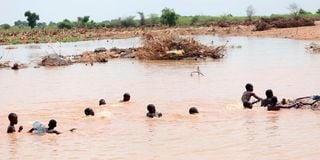Disruptive weather patterns demand disaster preparedness

Boys swimming in stagnant waters that brought by floods that cut off a section of the road at Madogo in Tana River County that leads to Garissa town on December 18, 2023.
What you need to know:
- To be well-prepared for emergencies, we should stay informed about weather alerts from NDMA and local authorities.
- Being aware of potential threats helps us to take timely precautions to protect ourselves and our loved ones.
Climate change disrupts the usual weather patterns, increasing floods, droughts, heat waves and other extreme weather events. The drought experienced between 2021 and 2022 is the longest in at least 40 years, resulting in a prolonged dry spell.
The drought caused severe food insecurity for over 4.2 million Kenyans, and their crops withered under the intense heat. Livestock, the primary livelihood source for many communities, perished in large numbers.
By February 2022, an estimated 1.5 million animals had died. The drought forced families to make tough decisions such as moving long distances for water and grazing land. This put their traditions and livelihoods at risk.
In 2019, heavy rains caused flooding in low-lying areas, leading to transport disruptions in Nairobi's major roads. Similarly, entire neighbourhoods were flooded in Kisumu, leading to significant damage and losses as residents were displaced.
These events are examples of the effects of climate change that are being witnessed globally. However, we can still weather these storms by embracing Disaster Risk Preparedness (DRP) as a shared responsibility. DRP is not solely the government's burden. It is a collective superpower that we can wield against climate challenges.
What is disaster risk Preparedness? DRP is not about predicting the future; it it is equipping ourselves with knowledge and resources to navigate the future's projected turbulence. Proper DRP will shield us from harsh effects and losses when the next disaster comes calling.
Why is DRP collaboration crucial? Numbers paint a stark picture. A recent World Bank study reveals that climate disasters cost Kenya three per cent of GDP annually. This staggering loss is more than the combined budgets of several key ministries and negatively impacts crucial sectors like healthcare, education and agriculture.
It translates to fewer doctors, teachers and agricultural extension workers, ultimately impacting the lives and livelihoods of millions of Kenyans. Worse still, the disaster aftermath burden is not evenly distributed. Rural communities, heavily reliant on agriculture and natural resources, are disproportionately affected, pushing them deeper into poverty and food insecurity.
Poor preparedness creates a vicious cycle, rendering the country more susceptible to future disasters, further impeding development.
A joint effort: Luckily, Kenya is not sitting idle. The National Disaster Risk Management Unit (NDMU) leads the charge, creating early warning systems, educating communities, and implementing risk reduction strategies. Local initiatives like water harvesting and drought-resistant crops are blossoming as communities share knowledge and build local resilience brick by brick.
Challenges, including unequal access to information and resources, expose vulnerable communities. Limited funding and competing priorities also hamper DRP efforts. We need all hands on deck for higher survival rates. Relevant government bodies, policymakers, community leaders and individuals all have a role to play.
While large-scale initiatives are essential, individual efforts are the foundation of collective preparedness needed to make our communities more resilient in the face of calamities.
To be well-prepared for emergencies, we should stay informed about weather alerts from NDMU and local authorities. Being aware of potential threats helps us to take timely precautions to protect ourselves and our loved ones.
We can create an emergency kit that contains essential items such as non-perishable food, clean water, first-aid supplies and important documents. To better tailor our preparations, we should consider items specific to our region and family's needs, like medication. Collaborating with neighbours is crucial to identify potential hazards in our community such as flood-prone areas, landslide risks or vulnerable infrastructure. Done well, this gives a community plan that outlines evacuation routes, designated shelters and communication strategies.
We can also share our knowledge and best practices with the broader community. Discussing disaster risk preparedness tips can increase awareness and foster collective preparedness. Awareness campaigns or workshops can empower our communities.
Finally, we should engage local leaders to advocate for more robust DRP policies. We can support initiatives that enhance early warning systems, disaster response infrastructure and community-based risk reduction measures.



